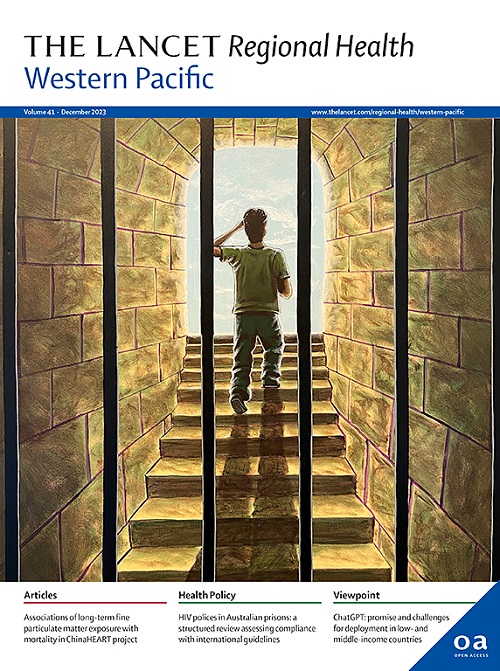Antimicrobial resistance in Neisseria gonorrhoeae in nine sentinel countries within the World Health Organization Enhanced Gonococcal Antimicrobial Surveillance Programme (EGASP), 2023: a retrospective observational study
IF 8.1
1区 医学
Q1 HEALTH CARE SCIENCES & SERVICES
引用次数: 0
Abstract
Background
The global spread of antimicrobial resistance (AMR) in Neisseria gonorrhoeae threatens empiric single-dose gonorrhoea treatment. Enhanced global AMR surveillance is imperative. We report i) gonococcal antimicrobial susceptibility and resistance data from 2023 in the World Health Organization Enhanced Gonococcal Antimicrobial Surveillance Programme (WHO EGASP) in the WHO Western Pacific Region (Cambodia, the Philippines, Viet Nam), Southeast Asian Region (Indonesia, Thailand), and African Region (Malawi, South Africa, Uganda, Zimbabwe), and ii) metadata of the gonorrhoea patients.
Methods
In 2023, WHO EGASP included men with urethral discharge (n = 3498) and gonococcal isolates (n = 2491). Minimum inhibitory concentrations (MICs, mg/L) values were determined for ceftriaxone, cefixime, azithromycin, gentamicin, and ciprofloxacin using Etest (bioMérieux). Breakpoints from the European Committee on Antimicrobial Susceptibility Testing (EUCAST) were applied. Clinical and epidemiological variables associated with AMR isolates were assessed using univariable and multivariable logistic regression analyses of odds ratios.
Findings
Overall, 3.8% (95% confidence interval (95% CI) 3.1–4.6%; 95/2487), 8.9% (95% CI 7.9–10.1%; 222/2484), 3.6% (95% CI 2.9–4.4%; 89/2487), and 95.3% (95% CI 93.2–97.5%; 1801/1890) of isolates were resistant to ceftriaxone, cefixime, azithromycin, and ciprofloxacin, respectively. All the ceftriaxone-resistant isolates were from Cambodia (15.3% (95% CI 11.5–20.1%), 42/274) and Viet Nam (20.4% (95% CI 15.9–25.7%), 53/260). In univariable analysis, ceftriaxone resistance was associated with travelling within the country during previous 30 days (OR 4.66, 95% CI 3.06–7.16; p < 0.001), and this association remained in multivariable analysis (aOR 4.12, 95% CI 2.65–6.65; p < 0.001).
Interpretation
Resistance to ceftriaxone, cefixime, and azithromycin is a major global concern, and expanded and improved resistance surveillance is essential. The WHO EGASP has been substantially expanded in the recent years. Additionally, resistance breakpoints have been harmonised and test-of-cure, whole-genome sequencing, and extragenital sampling implemented, where feasible. Novel antimicrobials for gonorrhoea treatment are critical; zoliflodacin and gepotidacin are promising.
Funding
WHO, Global Fund.
2023年世界卫生组织强化淋球菌抗菌素监测规划(EGASP)内九个哨点国家淋病奈瑟菌的抗菌素耐药性:一项回顾性观察研究
淋病奈瑟菌抗微生物药物耐药性(AMR)的全球传播威胁着经验性单剂量淋病治疗。加强全球抗菌素耐药性监测势在必行。我们报告i)世界卫生组织加强淋球菌抗菌药物监测规划(WHO EGASP)在世卫组织西太平洋地区(柬埔寨、菲律宾、越南)、东南亚地区(印度尼西亚、泰国)和非洲地区(马拉维、南非、乌干达、津巴布韦)的2023年淋球菌抗菌素敏感性和耐药性数据,以及ii)淋病患者的元数据。方法2009年WHO EGASP纳入有尿道分泌物的男性(n = 3498)和分离出淋球菌的男性(n = 2491)。最低抑制浓度(mic, mg/L)值测定头孢曲松,头孢克肟,阿奇霉素,庆大霉素和环丙沙星使用est (biomacrieux)。采用欧洲抗微生物药敏试验委员会(EUCAST)的断点。使用单变量和多变量logistic回归优势比分析评估与AMR分离株相关的临床和流行病学变量。总体而言,3.8%(95%置信区间(95% CI) 3.1-4.6%;95/2487)、8.9% (95% CI 7.9-10.1%; 220 /2484)、3.6% (95% CI 2.9-4.4%; 89/2487)和95.3% (95% CI 93.2-97.5%; 1801/1890)的分离株对头孢曲松、头孢克肟、阿奇霉素和环丙沙星耐药。所有头孢曲松耐药菌株均来自柬埔寨(15.3% (95% CI 11.5-20.1%), 42/274)和越南(20.4% (95% CI 15.9-25.7%), 53/260)。在单变量分析中,头孢曲松耐药性与前30天在国内旅行相关(OR 4.66, 95% CI 3.06-7.16; p < 0.001),多变量分析中这种关联仍然存在(OR 4.12, 95% CI 2.65-6.65; p < 0.001)。头孢曲松、头孢克肟和阿奇霉素耐药是全球关注的主要问题,扩大和改进耐药监测至关重要。近年来,世卫组织EGASP得到了大幅扩展。此外,已经协调了耐药性断点,并在可行的情况下实施了治愈试验、全基因组测序和生殖器外取样。治疗淋病的新型抗菌剂至关重要;唑氟达星和吉波替达星是有希望的。世卫组织,全球基金。
本文章由计算机程序翻译,如有差异,请以英文原文为准。
求助全文
约1分钟内获得全文
求助全文
来源期刊

The Lancet Regional Health: Western Pacific
Medicine-Pediatrics, Perinatology and Child Health
CiteScore
8.80
自引率
2.80%
发文量
305
审稿时长
11 weeks
期刊介绍:
The Lancet Regional Health – Western Pacific, a gold open access journal, is an integral part of The Lancet's global initiative advocating for healthcare quality and access worldwide. It aims to advance clinical practice and health policy in the Western Pacific region, contributing to enhanced health outcomes. The journal publishes high-quality original research shedding light on clinical practice and health policy in the region. It also includes reviews, commentaries, and opinion pieces covering diverse regional health topics, such as infectious diseases, non-communicable diseases, child and adolescent health, maternal and reproductive health, aging health, mental health, the health workforce and systems, and health policy.
 求助内容:
求助内容: 应助结果提醒方式:
应助结果提醒方式:


